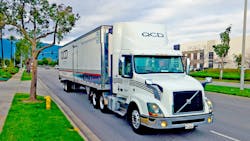How one fleet used data to optimize its routing strategy
Gone are the days of laying maps flat on a desk, using highlighters and sticky notes to indicate which roads to take and where to plan stops. Fleet route planning strategies have been significantly improved by mapping software. Yet, fleets that aren’t going the extra mile to optimize their routes—either manually or via optimization software—are leaving benefits on the table.
“In an ideal world, you would be able to get from A to B in the fastest amount of time, the shortest distance. There'd be no constraints,” Sabina Martin, VP of product management at Geotab, told FleetOwner. “But the reality is that routing is quite complex, and there are multiple variables that can come up on a day-to-day [basis] for a fleet.”
Route optimization is another way for fleets to use data and technology to improve efficiency by saving time and fuel as well as improving routes.
Capturing data such as “whether a driver calls in sick or work, or they go to their vehicle and it's not fueled … or they got on the road and they hit an unexpected accident or traffic conditions,” Martin said, “is foundational to help make sure that we can leverage technology and [artificial intelligence] ... to get ahead of that and be able to reroute drivers based off of all of those different conditions.”
Route optimization in the real world
Route optimization has multiple benefits to the fleet, even some that might be unexpected. One fleet, Quality Custom Distribution, a division of Golden State Foods, created its own route optimization platform to improve operations but also to cut down on its drivers’ fatigue. The company called this process its “digital route transformation journey.”
QCD previously had drivers use five different platforms for operations such as data gathering, route tracking, ELD compliance, and customer needs, Xavier Alcala, director of business solutions at QCD, told FleetOwner.
“We recognized that the complications of too many apps and tools burdened our drivers,” Alcala said. “Complete route insights required the use of multiple systems, which lead to inefficiencies and burnout with our drivers. Our strategy was simple—consolidate.”
See also: How fleet managers can avoid 'drowning in data'
While the company uses a third-party system to capture data, the data-driven solution QCD now uses was developed in-house to create a single platform that did the job of the previous five.
The platform includes all the drivers’ necessities, according to Alcala. It outlines routes, offers direct communication between drivers and their support teams, and has digital maintenance checklists, general administration tools, and even AI algorithms for optimum routing solutions. In addition, the platform allows customers access to a portal where they can find statements, delivery tracking, invoicing information, and customer support.
QCD observed noticeable changes in its fleet’s overall performance after implementing its digital transformation, Alcala told FleetOwner.
“On average, operations have been reduced by about 40 minutes each day, helping to eliminate driver fatigue,” Alcala noted. “QCD associates are now able to focus their attention on staffing and servicing our customers. Additionally, going paperless has given admin more time to service customers, as opposed to spending time filing away paperwork.”
Optimization requires data
Fleets that don’t yet have the ability to create their own proprietary solution can begin their own digital transformation in other ways through data.
“Management by measurement” is the phrase Martin used to highlight the importance of data when discussing optimization or fleet improvements in general. The data captured by the fleet determines those measurements.
“It’s really difficult for you to run your business if you don’t know where you stand, and you can’t use that data to help inform improvements but also to help leverage technology,” Martin told FleetOwner. “The foundation of being able to run a very efficient fleet is to use this data to help make sure that the routes are optimized to those ideal outcomes, such as … making sure [fleet drivers] are on time for their customers.”
Data capture offers fleets input such as its drivers’ location, which drivers are scheduled for work on any given day, and the nearest driver to a location that needs assistance at the last minute. Further, recent technology gives fleets transparency into traffic patterns, construction zones, weather conditions, and more.
Marrying data and routing gives fleets the ability to quickly process and analyze information for patterns and then develop data-driven decisions. Data allows route planning to become more dynamic and offers “tangible impacts” to fleets and businesses, Martin said.
It has “increased the accuracy of route planning,” Martin explained, which has “resulted in reduced fuel consumption” and improved on-time deliveries. As AI evolves, Martin believes route optimization will only get better. “I think the options are limitless,” Martin told FleetOwner.
See also: Overheated, overwhelmed: Navigating the new reefer technology landscape
Not only is it essential to measure a fleet’s performance for a healthier bottom line, but route optimization can also help give fleets an edge over competitors. This is especially true for fleets that leverage products that turn that data into predictive insights, such as route optimization software. Fleets that wait too long to implement data-driven performance metrics or data-driven insights might even find themselves falling behind in the very near future. The fleets that adopt this technology, however, will likely experience better customer service, on-time deliveries, and become safer fleets, Martin said.
Data—and now the use of machine learning and artificial intelligence—is “not just a trend or a pulse at the time,” Martin said. “It’s something that’s going to reshape the industry.”
About the Author
Jade Brasher
Senior Editor Jade Brasher has covered vocational trucking and fleets since 2018. A graduate of The University of Alabama with a degree in journalism, Jade enjoys telling stories about the people behind the wheel and the intricate processes of the ever-evolving trucking industry.

